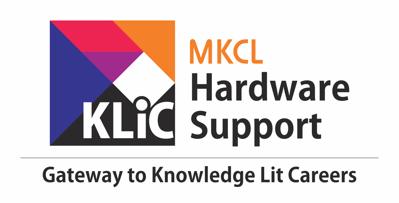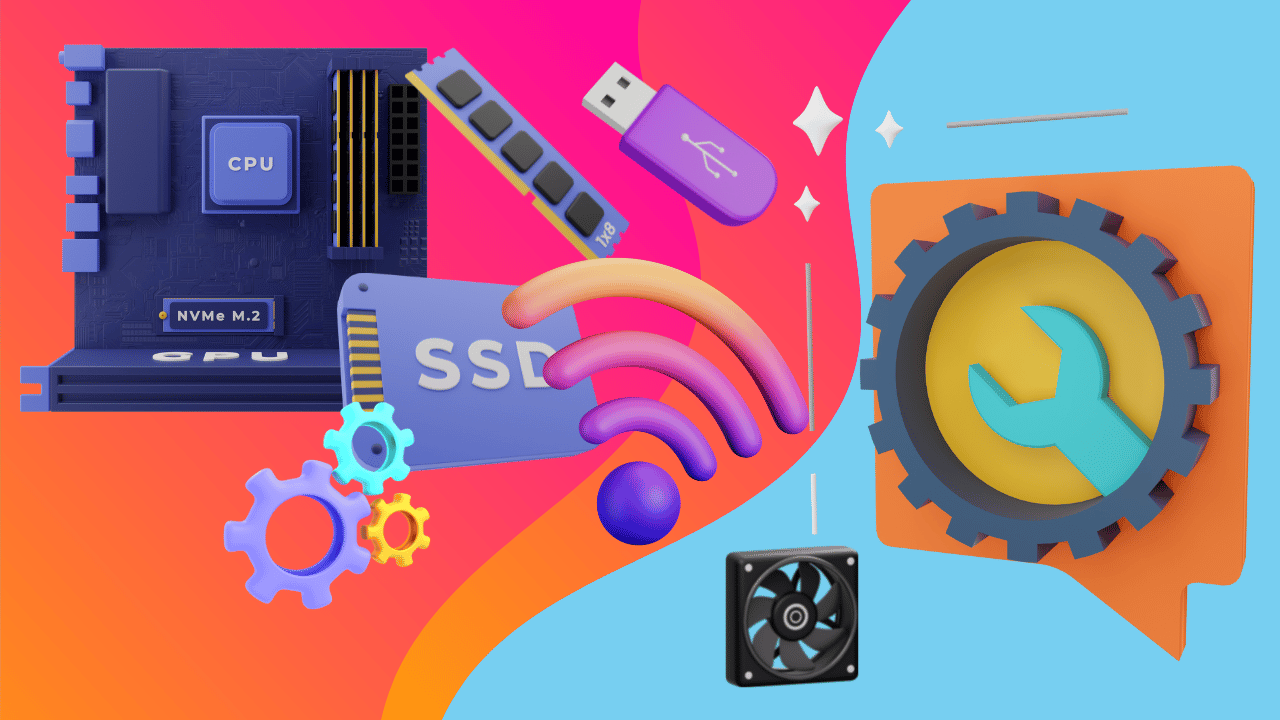- In this course, you will learn:
- Fundamental hardware components of a computer system, such as the motherboard, CPUs, RAM modules, HDDs, SSDs, projectors, and CCTV systems. They will learn to identify different types of projectors (e.g., LCD, DLP) and CCTV cameras (e.g., analog, IP).
- Details about how various components fit and function within a computer system, helping students understand the role of each part.
- Installation and configuration of the motherboard within a computer case, including how to secure it to the case, connect power cables, install CPU and RAM modules, and connect peripheral devices..
- Installing and configuring storage devices, such as hard disk drives (HDDs) and solid-state drives (SSDs), ensuring they are proficient in handling drive bays, motherboard slots, and expansion cards. This includes connecting data and power cables effectively.
- The principles, components, and functionalities of projectors and CCTV systems. Students will learn about different types of projection and camera technologies and apply this knowledge to set up basic operational setups.
- Installing operating systems from various media (e.g., optical discs, USB drives, network sources) onto bare-metal hardware or virtual machines. This involves following best practices for partitioning, formatting, and configuring disk storage to ensure a successful installation.
- List the differences between refurbished and new computers.
- Explain the factors to consider when choosing between a refurbished and a new computer.
- Effectively managing and maintaining a computing environment.

Mastering Installations and Troubleshooting of IT Hardware
Install, configure, and troubleshoot hardware components and peripheral devices.
Introduction
What you'll learn ?
- At the end of this course,, learners will be able to:
- Demonstrate the ability to install various hardware components by preparing the computer case, securely mounting components, connecting cables and interfaces, and configuring settings as needed.
- Install operating systems such as Windows and Linux, and appropriately integrate device drivers to ensure compatibility and functionality of hardware components.
- Analyze and troubleshoot common hardware installation issues, identifying underlying causes of compatibility conflicts, incorrect installations, hardware conflicts, and device driver problems.
- Examine and distinguish between different types of CCTVs and projectors, analyzing their principles of operation, component functionalities, and the appropriateness of various technologies (e.g., LCD, DLP, laser) and camera types (fixed, PTZ) for specific use cases.
- Make informed decisions about the selection and implementation of CCTV and projector systems based on performance metrics, resolution standards, and environmental variables.
- Compare the long-term performance and cost implications of refurbished versus new computers.
- Analyze the effectiveness of various sensors and cameras in different mobile devices.
- Implement a basic recycling program for mobile hardware components. Assess the economic and environmental benefits of different hardware recycling methods.
Syllabus
- Assembling a PC -Part 2
- Installing SMPS
- Installing various hardware components
- Installing Various Types of Hardware Components – Part 1
- Installing Various Types of Hardware Components – Part 2
- Installing Various Types of Hardware Components – Part 3
- Installing Various Types of Hardware Components – Part 4
- Installing Various Types of Hardware Components – Part 5
- Installing Various Types of Hardware Components – Part 6
- Installing Various Types of Hardware Components – Part 7
- Laptop components
- Laptop Components- Expansion Cards
- Laptop Components- Express Cards
- Laptop Components- RAM SODIMM SSD
- Laptop Hardware LCD Screens DJ Jack Battery Packs Touch Pads Plastic Fittings
- Laptop Hardware- Keyboard and Hard Drives
- Laptop Hardware- Speakers Motherboards
- Laptop Hardware-Memory and Optical Drives
- Inside a laptop
- Laptop Vs Tablet
- Opening a laptop
- What is HDMI over LAN?
- Braille Reader
- Speech-Generating Device
- Overview of Biometric Systems
- Types of Biometrics
- Advantages and Disadvantages of Biometrics
- Characteristics of Biometric system
- Security and Privacy Concerns
- UPS Overview
- UPS types
- Choosing Ups and Batteries
- Accessories and future trends
- Projectors and Types
- LCoS projector
- DLP projector
- LCD projector
- Pico projector
- About laser projector, buying guidelines and installing projector
- Laser projector and buying
- Installing projector (Demo)
- About CCTV and Working Part 1
- About CCTV and Working Part 2
- CCTV camera- storage and installation
- CCTV camera
- CCTV Monitoring and Troubleshooting
- CCTV installation (Demo)
- Thin Clients - Part 1
- Thin Clients - Part 2
- Mobile device management (MDM) overview
- Operating system overview, working and installing Virtual PC software on PC
- Operating system overview part 1
- Operating system overview part 2
- Working With Operating System Part-1
- Working With Operating System Part-2
- Installing Virtual PC software on PC
- Downloading iso image
- Creating bootable pen drive
- Installing Windows desktop operating system
- Installing Windows 11 operating system
- Installing Ubuntu operating system
- Creating users in Windows 10
- Checking operating system information in a PC
- Disk Partitioning in Windows 10
- Setting password policies in Windows 10
- Partitioning Basics (1)
- Partitioning Basics (2)
- Understanding File Systems
- Bit Locker drive encryption
- Importance of Antivirus Software
- Antivirus part -1
- Antivirus part -2
- Antivirus part -3
- Troubleshooting Methodology
- Importance of Earthing
- About Hardware Troubleshooting Part-1
- About Hardware Troubleshooting Part-2
- About Hardware Troubleshooting Part-3
- About Hardware Troubleshooting Part-4
- Common Problems and Solutions Part-1
- Common Problems and Solutions Part-2
- Troubleshooting Adaptor Card
- Troubleshooting Cooling Systems
- Troubleshooting Hard Drive
- Troubleshooting Laptop Components
- Troubleshooting Power Supply
- Diagnostic Software's I
- Diagnostic Softwares-1
- Hard disk Utility-1
- Diagnostic Softwares-2
- Performance Utilities -1
- Performance Utilities
- Mobile hardware
- SoC and memory
- About camera and sensors
- Connecting a Mobile Device to a PC
- Hardware Recycling Part 01
- Hardware Recycling Part 02
- About Refurbishing in Hardware
- Understanding process
- Refurbishing and New Computers
- How to buy a Good PC or Laptop 1
- How to buy a Good PC or Laptop 2
- Managing Your Computing Environment
- Communication Skills-1
Certificate
- MKCL provides certificate (for 30/60/90 hours courses) to the KLiC learner after his/her successful course completion.
Academic Approach
The Academic Approach of the course focuses on the “work centric” education i.e. begin with work (and not from a book !), derive knowledge from work and apply that knowledge to make the work more wholesome, useful and delightful. The ultimate objective is to empower the Learner to engage in socially useful and productive work. It aims at leading the learner to his/her rewarding career as well as development of the society.
Learning methodology
- Learners are given an overview of the course and its connection to life and work.
- Learners are then exposed to the specific tool(s) used in the course through the various real-life applications of the tool(s).
- Learners are then acquainted with the careers and the hierarchy of roles they can perform at workplaces after attaining increasing levels of mastery over the tool(s).
- Learners are then acquainted with the architecture of the tool or Tool Map so as to appreciate various parts of the tool, their functions and their inter-relations.
- Learners are then exposed to simple application development methodology by using the tool at the beginner’s level
- Learners then perform the differential skills related to the use of the tool to improve the given ready-made outputs.
- Learners are then engaged in appreciation of real-life case studies developed by the experts.
- Learners are then encouraged to proceed from appreciation to imitation of the experts.
- After imitation experience, they are required to improve the expert’s outputs so that they proceed from mere imitation to emulation.
- Finally, they develop the integral skills involving optimal methods and best practices to produce useful outputs right from scratch, publish them in their ePortfolio and thereby proceed from emulation to self-expression.
Evaluation Pattern
Evaluation Pattern of KLiC Courses consists of 4 Sections as per below table:
| Section No. | Section Name | Total Marks | Minimum Passing Marks |
|---|---|---|---|
| 1 | Learning Progression | 25 | 10 |
| 2 | Internal Assessment | 25 | 10 |
| 3 | Final Online Examination | 50 | 20 |
| Total | 100 | 40 | |
| 4 | SUPWs (Socially Useful and Productive Work in form of Assignments) | 5 Assignments | 2 Assignments to be Completed & Uploaded |
MKCL’s KLiC Certificate will be provided to the learner who will satisfy the below criteria:
- Learners who have successfully completed above mentioned 3 Sections i.e. Section 1, Section 2 and Section 3
- Additionally, learner should have completed Section 4 (i.e. Section 4 will comprise of SUPWs i.e. Socially Useful and Productive Work in form of Assignments)
- Learner has to complete and upload minimum 2 out of 5 Assignments
Courses Fee Structure from 01 July, 2025 Onwards
KLiC 30 hour course fee applicable from 01 July, 2025 all over Maharashtra| KLiC Course Duration | MFO: MKCL Share (Including 18% GST) |
ALC Share (Service Charges to be collected by ALC) |
|---|---|---|
| 30 hours | Rs. 300/- | Rs. 1,500/- |
Important Points:
* Above mentioned fee is applicable for all Modes of KLiC Courses offered at Authorised Learning Center (ALC) and at Satellite Center
* Total fee is including of Course fees, Examination fees and Certification fees
* MKCL reserves the right to modify the Fee anytime without any prior notice
* Above mentioned fee is applicable for all Modes of KLiC Courses offered at Authorised Learning Center (ALC) and at Satellite Center
* Total fee is including of Course fees, Examination fees and Certification fees
* MKCL reserves the right to modify the Fee anytime without any prior notice
